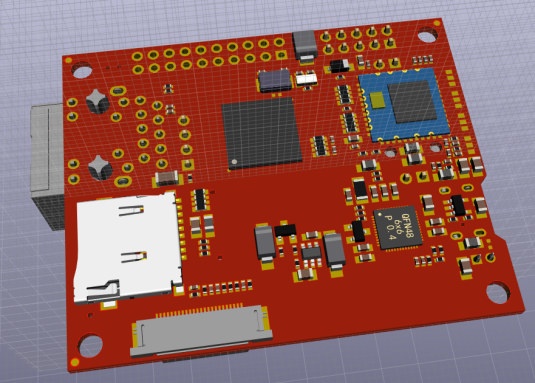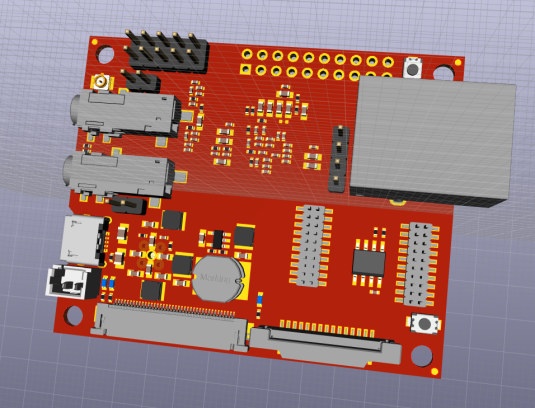Allwinner S3 Arm Cortex-A7 processor is designed for dual-camera systems and embeds 128MB RAM. It looks to be an evolution of the older Allwinner V3s chip that came with 64MB RAM and is software-compatible with the older camera SoC.
We reported about the new processor and an Allwinner S3 development board last year, but Olimex has started working on an open-source hardware IP camera board based on the processor and is asking for feedback from customers and the community at large.
Preliminary specifications:
- SoC – Allwinner S3 Cortex-A7 @ 1.2GHz with 128MB DDR3 RAM at 1333 MHz
- Storage -MicroSD card slot, configuration EEPROM, optional NAND/eMMC/SPI Flash on socket
- Camera I/F
- MIPI camera connector with RPi pinout
- Parallel CSI camera connector
- Display – LCD connector for LCD-OLinuXino 4.3″ to 15.6″ displays
- Audio – Audio in and out via 3.5mm audio jacks
- Connectivity
- Fast Ethernet with PoE option
- WiFi / BT module with RTL8723BS
- Expansion – UEXT connector
- Misc – Buttons
- Power Supply
- 5V via Micro USB port
- Lipo battery connector
- AXP209 PMU with Lipo charger and step-up for UPS
- Dimensions – 60 x 50 mm
The Allwinner S3 IP camera board could also find potential uses for VoIP, Video over IP, security, home remote monitoring, and more.
The KiCAD schematics, 3D rendering, and S3 datasheet can already be found on Github. Some suggestions from the community already include infrared camera support, exposing I2S pin on headers, dual-band WiFi options, industrial grade, and more.
It should be noted the Allwinner Linux SDK for the chip was made in 2012 and relies on Linux 3.4 with a lot of it being closed source. There’s mainline support for the chip with working H.264 decode and parallel CSI camera support working, but H.264 encode, the ISP and MIPI are not supported in mainline. There are already some discussions about subcontracting Bootlin for the work.
If you have suggestions and/or would like to get involved/help with mainline support, you can provide your feedback in the comments section of Olimex’s blog post.
Thanks to Jon for the tip.

Jean-Luc started CNX Software in 2010 as a part-time endeavor, before quitting his job as a software engineering manager, and starting to write daily news, and reviews full time later in 2011.
Support CNX Software! Donate via cryptocurrencies, become a Patron on Patreon, or purchase goods on Amazon or Aliexpress. We also use affiliate links in articles to earn commissions if you make a purchase after clicking on those links.







IMHO if it’s not smaller/cheaper than some of the OrangePI boards there isn’t much point messing with the S3 chips.
You need to be familiar with buildroot or yocto to build anything that’ll fit in the memory while actually being useful and unless it’s smaller/cheaper then there isn’t much point messing with that stuff.
The camera system on S3 is much better than normal Allwinner chips. S3 can do 4K 15FPS h.264. It also has an ISP with important features like 3D denoise. Allwinner chips without ISP make 6Mb/s stream for 1080P h.264. With ISP same stream is about 2Mb/s. The 3D denoise stops pixel twinkle between frames. That pixel twinkle gets h.264 encoded and blows up the size of the streams. S3 also quite cheap, a little over $3 for 128MB version.
The $40 4K action cams that are everywhere use the Allwinner V3. A V3 is identical to S3, except it has external DRAM. The external DRAM supports a little bit higher performance.
https://www.aliexpress.com/item/32855114556.html
If you ignore the camera improvements, the chip is basically an H3 with 128MB embedded DRAM.
I can see the advantages but I’m not sure how many people really want all of the advanced camera bits in a raw form like this. If I wanted that stuff I would buy a $5 IP board cam off of taobao, use the horrible firmware long enough to set it up and then exile it to a vlan.
Most of those cameras have Hisilicon chips in them made by Huawei. They are being banned in many locations (like the whole US government). The Hisilicon camera firmware has large pieces that are closed source. S3 offers possibility of completely open source solution.
I know Olimex wants this board to build factory automation on their own production lines. The NEON unit can run decent AI code. Hisilicon chips only have ARM9 CPU. Camera is going to look at board being manufactured and then make AI decisions. My client using it to make video intercoms. He wants S3 because of size – integrated DRAM.
If you use off-the-shelf camera board you have to decode h.264 stream on another box before AI can look at it. That adds a lot of delay.
The Allwinner V5 was really meant for these applications but Allwinner got unlucky and picked the wrong AI technique (HAAR vs CNN). You can’t fault them for that because the discovery that made CNN so good came after they did the chip design. Allwinner is working on new Vx chip with CNN support.
The $5 ones I have are the MStar ones. The latest $5 ones seem to be A7 + 128MB DDR like the S3.
I made comment about MSTAR SSC8339D on Olimex thread. As far as I know no one has been in contact with them. I asked some people people in Shenzhen to talk to them, but they never made the call. I think Mediatek owns MSTAR now and Sigmastar is brand of MSTAR. That chip has good potential but someone in China is going to have to get access to everything, they don’t appear to be set up to deal with foreigners.
I have a contact in Shenzhen that can get the chips directly but the MOQ is 2080 units.
The SSC8339D is interesting but they also have a QFN version with 128/256MB of DDR in chip now and the modules with those chips are ~$5 (https://item.taobao.com/item.htm?id=560933796582&spm=1101.1101.N.N.2d7ebf8).
Info is slowly getting added here: http://linux-chenxing.org/
Need to see the SSC8339D SDK to assess the state of their software. We have to have LCD controller. Can your guy post the SDK so that we can figure out of this is worth pursuing?
Maybe he can talk to Sigmastar about working with Olimex. The world-wide visibility this would get Sigmastar is quite large and it costs them almost nothing. Olimex products distributed all over US and EU.
>Need to see the SSC8339D SDK to assess the state of their software.
I’d like to see it too but as I want to mainline support for their chips I don’t want to sign NDAs etc. The differences between their chips are pretty subtle (configuration of the video encoders they have licensed, number of DMA controllers etc). The stuff needed to get to a buildroot login is all in the same places as far as I can tell.
The SSC8339D seems to actually run an RTOS despite it being almost exactly the same chip as the ones they ship with Linux. If you search for “AIT8328” you can find a really old version of that SDK.
>We have to have LCD controller.
The SSC8336N dashcam I have on my desk has an LCD so that’s in there. Source for the frame buffer block is available.
>Can your guy post the SDK
>so that we can figure out of this is worth pursuing?
He’s just a component guy but I can ask. The plan was to get the funding together via crowdsupply to buy the chips, build some boards and put chips onto the open market…
Sigmastar has a site now too http://www.sigmastarsemi.com/en/products/list.aspx?lcid=55
I filled out contact form, we’ll see if they reply. Form on the English pages does not work, one on the Chinese page does.
I contacted one of their partners (Unifore I think) at the beginning of last month, but not answer so far.
I do not think that any of those IP camera modules have display port. The main advantage of V3/S3 is relatively low power consumption and high component integration – RGB/LVDS display port, Ethernet PHY … which are barely available in other SoCs. For some specific custom devices – video intercoms, hand-held devices V3/S3 seems more suitable. Still this is a consumer grade chip …
>I do not think that any of those IP camera modules have display port.
The chips on them might have DSI. The same families of chips are also used in drive recorders with a display.
>The main advantage of V3/S3 is relatively low power
>consumption and high component integration –
For power consumption the RK3308 is a lot better. There is a G version with DDR integrated. It just lacks the camera parts I think. Modules with everything to go are already in the $10 range.
>For some specific custom devices – video intercoms, hand-held devices V3/S3 seems more suitable.
I agree. But I think if you’re making something like that you will use this a reference for your own layout or you want a small solder down module. That’s why a board like this doesn’t seem to have a niche to me.
The complete system on a chip A7s certainly do have their uses.
If you’re not familiar with those and willing to work with those…you’re probably not the intended market for this class of device/project, to be honest with you.
I’m fine working with those. I wouldn’t bother to do it for a board that is as big/expensive as a lot of very capable cheap SBCs out there. You can get a Cortex A7 like this with memory into about an inch of board. If you need to get down to that size then having to use higher pay grade tools is part of the deal.
Bootlin has posted two intern jobs for doing work on S3.
Video encoding on Allwinner VPU in the Linux kernel. This internship is about implementing a Linux kernel driver for hardware accelerated H264 video encoding on Allwinner ARM CPUs, and contributing this driver to the mainline Linux kernel.
Linux kernel driver for the MIPI CSI-2 controller in Allwinner SoCs. This internship will allow to implement a Linux kernel driver supporting the CSI-2 camera interface, and supporting the associated camera using this interface. The code will then be submitted to the Linux kernel community for inclusion in the mainline version.